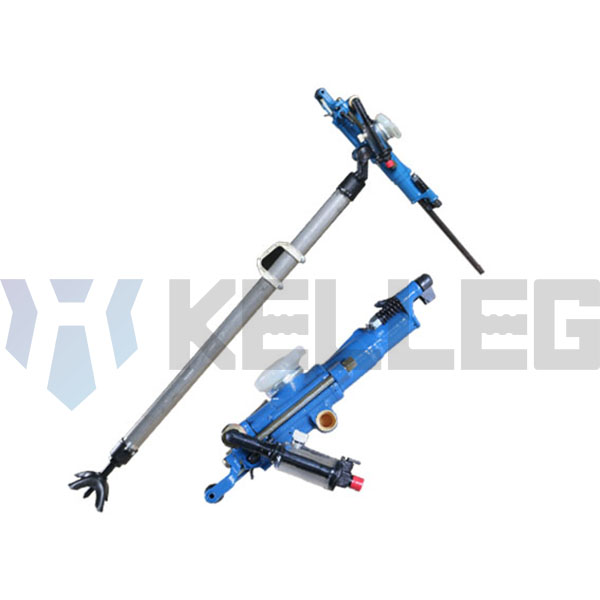2020 官网升级中!现在您访问官网的浏览器设备分辨率宽度低于1280px请使用高分辨率宽度访问。
The hydraulic rock drill is a new type of rock drill with various functions such as impact, rotation, propulsion, and flushing. It is widely used in road construction, infrastructure construction, mining, and other industries. Although it is simple to operate, its structure is very complicated. It is composed of an impact part, a rotating part, and a water injection tank. The impact part includes a casing, a cylinder, an accumulator, a reversing element, an impact piston, and a buffer piston. The rotary part includes the rotary motor, drive shaft, gear chamber, driving gear, drive gear, spline sleeve, and shank adapter. These parts interact with each other and cooperate with high precision, making the hydraulic rock drill more efficient in tunneling. Today, we will mainly share with you the working principle and precautions of hydraulic rock drills.

Hydraulic rock drills work on the principle of impact crushing. When working, the piston reciprocates at a high frequency and continuously impacts the shank adapter. Under the action of the impact force, the sharp wedge-shaped drill bit crushes the rock and digs it to a certain depth, forming a dent. After the piston returns, the drill turns a certain angle, the piston moves forward, and when it hits the shank adapter again and formed a new dent. The fan-shaped rock block between the two dents is sheared by the horizontal component force generated on the drill bit. The piston continuously impacts the shank adapter, and continuously inputs compressed air or pressurized water from the center hole of the drill, discharging the rock slag out of the hole, forming a circular hole with a certain depth.
Through the working principle of the hydraulic rock drill, we already know that as long as the hydraulic rock drill starts to work, its impact piston will come into contact with the shank, and a high-frequency reciprocating or rotary motion will occur. In addition, the hydraulic rock drill operates in a relatively harsh environment and may face different geological conditions. To improve the performance and life of the hydraulic rock drill, what precautions do we need to know?
1. The newly purchased rock drill is coated with a viscous anti-rust grease inside, which must be disassembled and cleaned before use. When reassembling, the surface of the moving parts should be lubricated. Once installed, check whether its operation is normal.
2. Inject lubricating oil into the automatic oiler. The container for lubricating oil should be clean and covered to prevent rock dust and dirt from entering the oiler.
3. Check the wind and water pressure at the workplace.
4. When the air pipe is connected to the rock drill, it should be deflated to blow out the dirt in the pipe. For water line, flush to clean the joint.
5. Insert the shank adapter into the rock drill head, and turn it clockwise. If it does not move, it means that the machine is jammed and should be dealt with in time.
6. Tighten the connecting bolts and check the operation of the propeller. It must be running well before it can start working.
7. For hydraulic rock drills, the hydraulic system should be required to have good sealing to prevent the hydraulic oil from being polluted and to ensure that the hydraulic oil has constant pressure.
8. When excavating, it should be turned slowly, and after the depth of the hole reaches 10-15mm, it will gradually turn into full operation.
9. The shaft thrust should be reasonably tested when drilling.
10. Regularly observe the powder discharge situation. When the powder discharge is normal, the mud flows out slowly along the orifice. Otherwise, blow the hole strongly. If it is still invalid, check the state of the water hole and the shank adapter of the drill, then check the water needle, and replace the damaged parts.
11. Pay attention to observing the oil reserve and output, and adjust the oil amount.
12. Pay attention to the sound of the machine during operation, observe its operation, find problems and deal with them in time.
13. Pay attention to the working state of the drill, and replace it in time if there is an abnormality.
14. Pay attention to the rock situation, avoid perforation along the bedding, joints, and fissures, prohibit breaking the residual rock, and observe at any time if there is the risk of roof collapsing.
15. Use the hole-opening function effectively. It is accomplished with reduced impact pressure and fixed propulsive pressure. The thrust pressure should be as low as possible to facilitate drilling on very steep rock faces and to avoid bending the drill rod.
Understanding the precautions of hydraulic rock drills can help us to use them more scientifically and rationally, which is not only of great significance to ensure production safety but also can improve the performance and working life of the equipment. Therefore, it is essential to understand the working principle and precautions of hydraulic drills for every user.